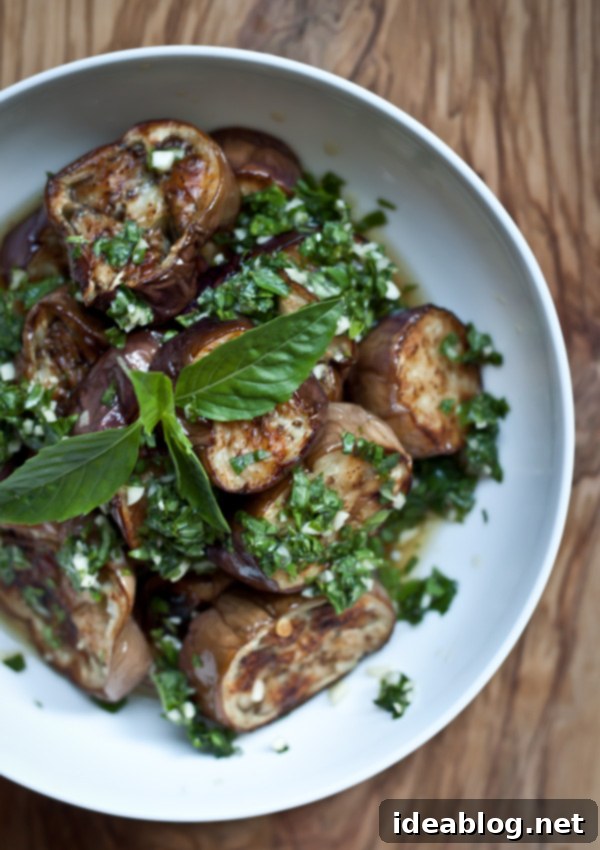Irresistible Broiled Japanese Eggplant with Zesty Thai-Inspired Lime-Fish Sauce
Discover a remarkably simple yet profoundly flavorful dish: succulent Japanese eggplant slices, perfectly broiled to a creamy tenderness in the oven, then exquisitely complemented by a vibrant sauce crafted from fresh lime juice, savory fish sauce, aromatic garlic, and a hint of sugar. This recipe transforms humble eggplant into an extraordinary culinary experience.
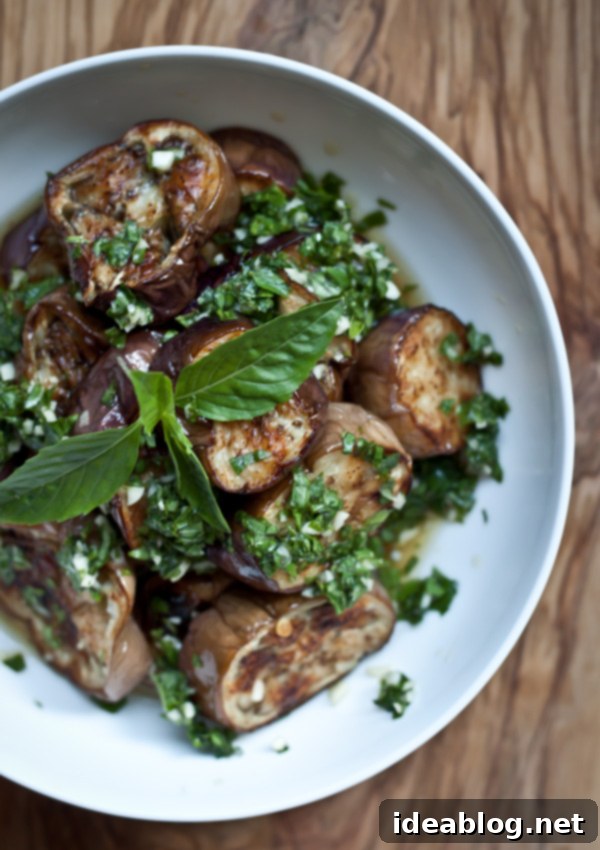
Embarking on a new recipe series can often feel like a delightful challenge, and when I first conceived the idea, I naively assumed that selecting the inaugural dish would be the easiest part. Oh, how wrong I was! It quickly became apparent that this seemingly straightforward task was, in fact, the most formidable hurdle. I had convinced myself that for a debut post, I needed to unearth the most complex, unique, and challenging culinary creation imaginable. This self-imposed pressure, as it often does, led me down a rabbit hole of over-analysis – a trait I’m admittedly prone to – and an almost absurd level of pickiness. Each recipe I considered felt either not challenging enough, too common, or simply not “special” enough to kick off a new journey.
Fortunately, after much internal debate, a moment of clarity (or perhaps just exhaustion from overthinking) prevailed. I managed to talk some sense into myself, realizing that the essence of good cooking, and indeed good blogging, lies not in grandiosity but in authenticity and deliciousness. The goal wasn’t to impress with difficulty, but to inspire with flavor and accessibility. I decided to shed the burden of perfection and simply, as the saying goes, “just do it already.”
The irony wasn’t lost on me when, after all that deliberation, I ended up choosing an incredibly simple yet profoundly satisfying Thai Eggplant dish. This culinary gem, from start to finish, demands merely 20 to 25 minutes of your time, proving that extraordinary flavors don’t always require hours in the kitchen. Its elegance lies in its straightforward preparation and the harmonious balance of its vibrant ingredients, making it an ideal candidate for any weeknight meal or a quick, impressive side dish.
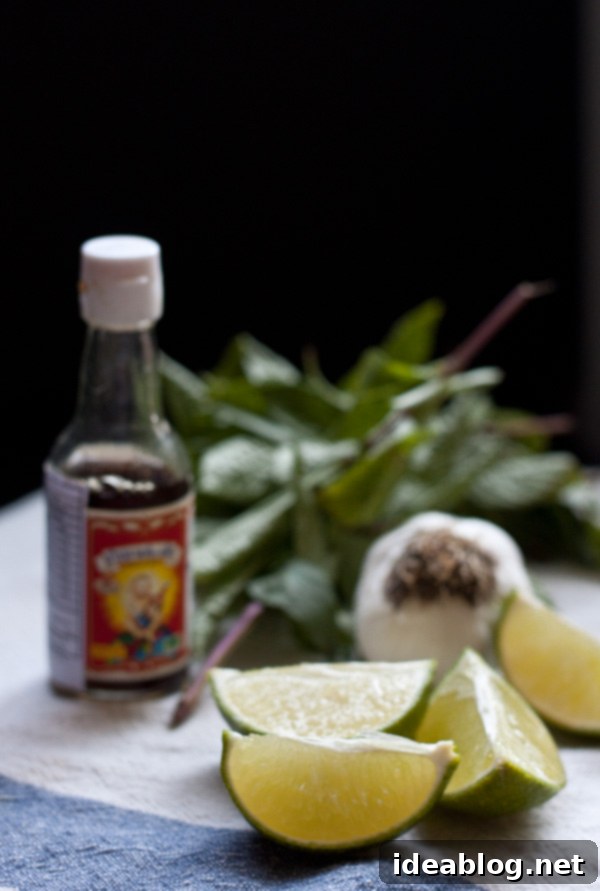
With a stack of vintage magazines at my disposal, the sheer volume of choices felt overwhelming. To narrow down the selection, I wisely decided to focus on the summer issues. After all, recommending a rich, hearty stew in the scorching heat of August, no matter how delicious, felt somewhat out of touch with the season’s culinary desires. The lighter, fresher flavors of summer naturally beckoned.
Leafing through a classic June 1994 issue of Gourmet magazine, a venerable publication renowned for its timeless recipes, my eyes paused at an article titled, “A Taste of Thailand.” This feature promised a culinary journey through Southeast Asia, presenting an enticing array of dishes. It included recipes for a delicately spiced shrimp soup, succulent roasted marinated Cornish hen with a sweet chili sauce, silky rice noodles, a refreshing cucumber carrot salad, and, intriguingly, sticky rice with mango and minted eggplant rounds. Each description was a sensory delight, painting a vivid picture of exotic flavors and aromatic spices.
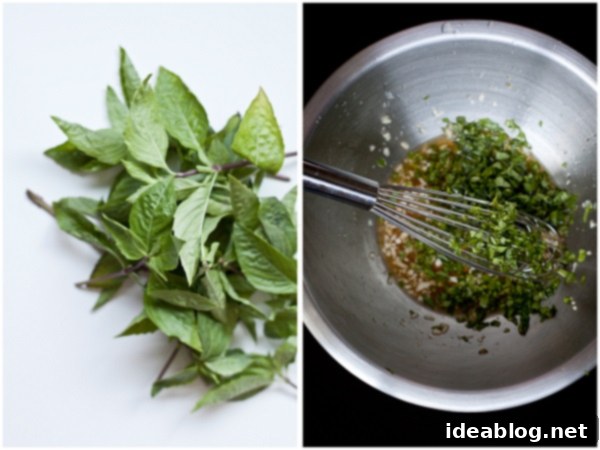
Perhaps it was my inherent affection for eggplant, or the serendipitous fact that I had some beautiful Japanese eggplant patiently waiting in my refrigerator, but that last item – the “minted eggplant rounds” – truly captivated my attention. It was a dish I hadn’t encountered before in such a context, and its simplicity, paired with the promise of Thai flavors, piqued my culinary curiosity. Japanese eggplant, with its slender shape, delicate skin, and fewer seeds, is particularly well-suited for broiling, offering a creamy texture that is hard to resist.
I must confess, I approached the recipe with a fair degree of skepticism. My experience with international cuisine recipes from the 1980s and 1990s often led to questions about their authenticity. This was an era, after all, when a simple jalapeño pepper was, I quote, considered a “hard-to-find” specialty food item, indicative of a less globally connected culinary landscape. Many recipes from that time often ‘Americanized’ or simplified exotic flavors, sometimes losing their true essence. However, a flicker of hope ignited when I scanned the ingredients list and spotted “naam pla,” the unmistakable Thai fish sauce. The inclusion of such a foundational and potent ingredient suggested a more genuine approach to Thai flavors, alleviating some of my initial reservations and promising an authentic taste experience.

Ultimately, curiosity triumphed over skepticism. I decided to silence my inner critic, head into the kitchen, and simply start cooking. The recipe began with a straightforward instruction: slice the Japanese eggplant into uniform rounds, typically about ¾-inch thick. This ensures even cooking and a consistent texture. Each side of these rounds was then lightly brushed with a neutral vegetable oil. The magic truly happened under the broiler. Placed on a sheet pan, the eggplant slices were broiled in the oven for a mere 4 to 5 minutes per side. It was crucial to watch them carefully, as broilers can vary in intensity and eggplant can go from perfectly golden to charred in moments. At this precise point, the eggplant underwent a remarkable transformation, softening to an amazingly tender, almost creamy texture that was incredibly satisfying. The high heat of the broiler caramelizes the surface slightly while cooking the interior to a melt-in-your-mouth consistency, making for an utterly delightful bite.
While the eggplant was cooking, my attention turned to the sauce – an incredibly simple yet profoundly flavor-packed concoction. It comprised freshly squeezed lime juice, which provides a bright, acidic counterpoint; high-quality fish sauce (like the recommended Red Boat brand), delivering that essential salty, umami depth; finely minced garlic, offering a pungent aromatic kick; and just a touch of granulated sugar to balance the acidity and salt. The original Gourmet recipe called for fresh mint leaves, but I decided to make a substitution that I believed would elevate the dish even further: fresh Thai basil. Thai basil, with its distinct anise-like, peppery, and slightly spicy notes, adds a more complex and authentic aromatic profile to the sauce, marrying beautifully with the other ingredients to create a truly unforgettable dressing.
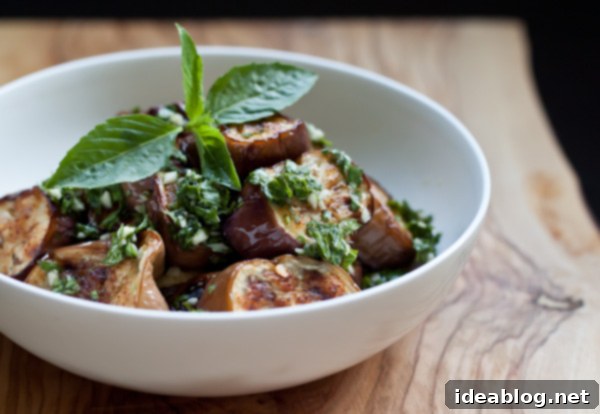
Tips for Achieving Perfect Broiled Eggplant
- **Uniform Slices:** Ensure your eggplant slices are of consistent thickness (¾-inch is ideal) for even cooking.
- **Don’t Overcrowd:** Arrange eggplant slices in a single layer on your sheet pan, leaving space between them. This promotes even browning and prevents steaming. You may need to work in batches.
- **Light Oil Brush:** A light brush of oil is all you need. Too much oil can make the eggplant greasy.
- **Keep an Eye on It:** Broilers are powerful. Stay near the oven and check the eggplant frequently. It can burn quickly!
- **No Salt Before Broiling:** Salting eggplant before broiling can draw out moisture, leading to a less creamy texture. Add salt to taste after cooking, if desired, or rely on the fish sauce for salinity.
Without any incredibly high expectations, given my initial skepticism, I tentatively dug my fork into the bowl for the first bite. The immediate sensation was one of pure delight. Despite my earlier reservations, I ended up truly falling in love with this dish. My initial impression was that it tasted incredibly authentic, a genuine reflection of Thai flavors despite its vintage magazine origin. For such a seemingly simple combination of ingredients and straightforward preparation, the dish really stood out, proving that sometimes the best culinary experiences are found in understated elegance.
The magic of this Thai eggplant recipe lies in its perfectly balanced flavor profile. The vibrant lime juice introduces a refreshing brightness and a zesty tang that cuts through the richness of the eggplant. The aromatic Thai basil adds its unique, slightly spicy, and anise-like notes, infusing the dish with an irresistible herbaceousness. Meanwhile, the fish sauce contributes just enough of that complex salty umami flavor – a quintessential element of Thai cuisine – to make the tender eggplant slices truly pop. Each ingredient plays a crucial role, creating a symphony of tastes that is both refreshing and deeply satisfying. This broiled Japanese eggplant makes for a fantastic side dish, a light appetizer, or even a delightful vegetarian main course when served over a bed of jasmine rice. It’s an effortless way to bring bold, authentic Thai flavors to your table, proving that often, the simplest recipes yield the most profound culinary joy.
Why Japanese Eggplant?
Japanese eggplant differs from its larger globe-trotting cousin in several key ways, making it ideal for this recipe:
- **Delicate Skin:** Its thin skin doesn’t require peeling and cooks down beautifully, becoming tender and barely noticeable.
- **Creamy Texture:** Japanese eggplant tends to have a silkier, creamier texture when cooked, especially when broiled, which is perfect for absorbing the vibrant sauce.
- **Fewer Seeds:** Generally, it contains fewer seeds than globe eggplant, resulting in a less bitter taste and a more pleasant eating experience.
- **Faster Cooking:** Its slender shape means it cooks more quickly and evenly, which is a huge advantage for a quick weeknight meal.
Serving Suggestions & Variations
This broiled Thai eggplant is incredibly versatile. Here are a few ideas:
- **As a Side Dish:** It pairs wonderfully with grilled chicken, fish, or tofu. The bright flavors cut through richer mains.
- **With Rice:** Serve it alongside a bowl of fluffy jasmine rice for a light and satisfying vegetarian meal.
- **Appetizer:** Arrange the cooled eggplant rounds artfully on a platter for an impressive appetizer.
- **Add Heat:** For those who enjoy a kick, sprinkle a pinch of red pepper flakes into the sauce.
- **Garnish:** A scattering of chopped roasted peanuts or toasted sesame seeds can add a delightful crunch and nutty flavor.
- **Vegetarian/Vegan Option:** For a plant-based alternative, substitute the fish sauce with a high-quality vegetarian fish sauce or a dash of soy sauce mixed with a pinch of seaweed flakes for umami.

Thai Eggplant Rounds
Pin
Review
SaveSaved!
Equipment
-
Half Sheet Pan
Ingredients
- 2 Japanese eggplant
- vegetable oil for brushing
- 2 tablespoons (30 mL) fish sauce I recommend Red Boat brand
- 2 tablespoons (30 mL) fresh lime juice
- 2 small garlic cloves finely minced
- 1 teaspoon (5 g) granulated sugar
- ¼ cup packed Thai basil leaves finely chopped
- freshly ground black pepper
Instructions
-
Preheat oven to the medium broil setting. Slice the eggplant into ¾-inch thick round slices and lay out on a half sheet pan, leaving some space between each slice.
-
Brush both sides with oil, do not salt, and broil for 4 to 5 minutes per side, watching carefully, or until each side is golden brown. Meanwhile, combine the fish sauce, lime juice, garlic, sugar, and Thai basil in a small bowl, whisking until the sugar has fully dissolved.
-
Allow the eggplant to cool on a wire rack for 15 to 20 minutes or until lukewarm. Drizzle with the sauce and serve immediately.
